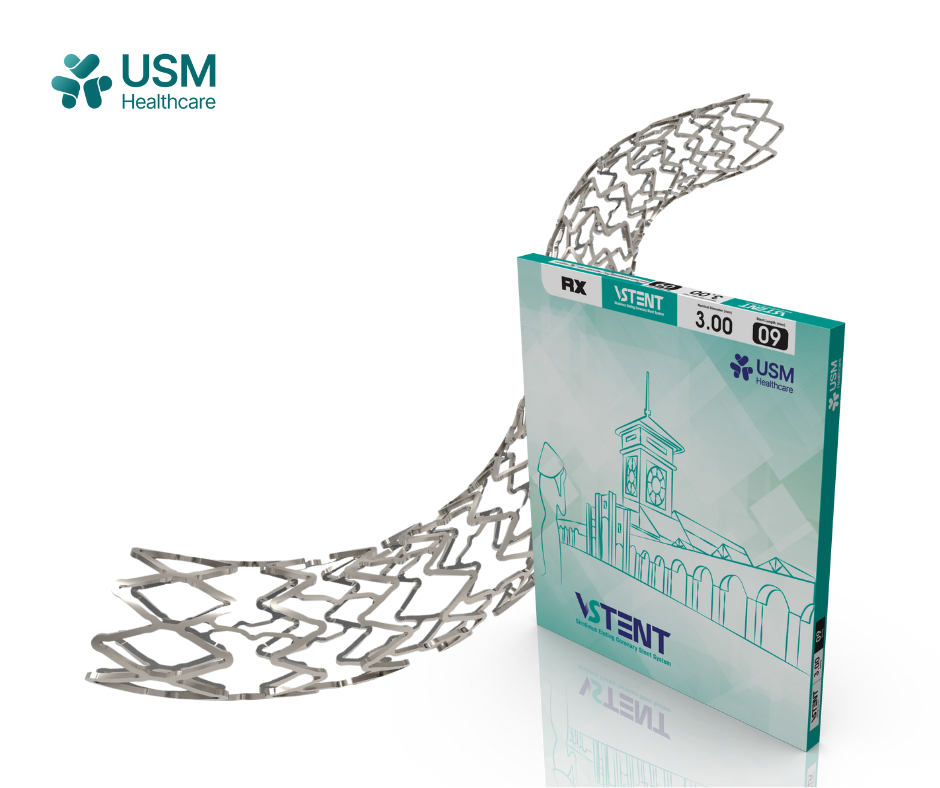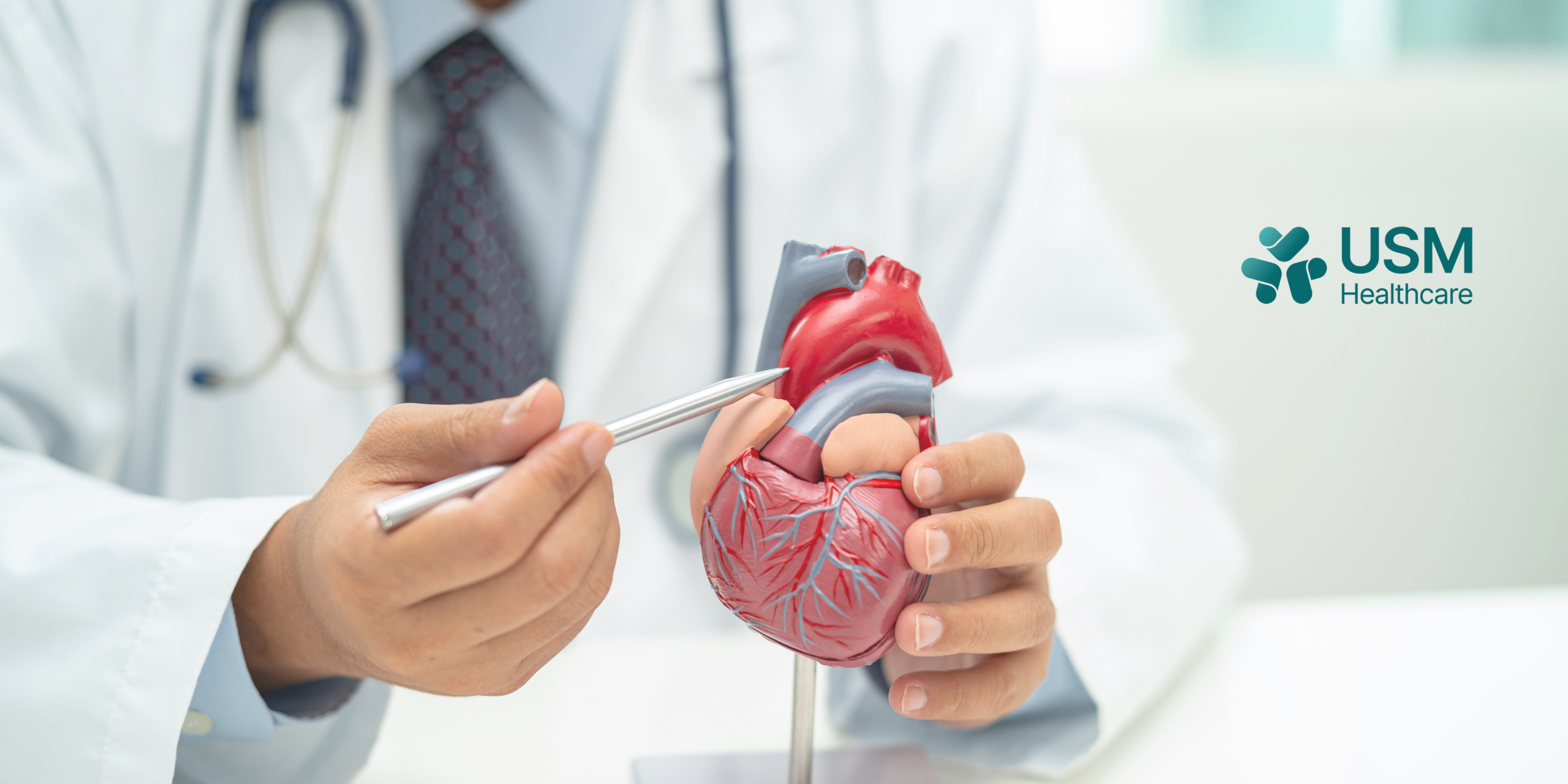OVERVIEW OF CORONARY ARTERY DISEASE
I. What is Coronary Artery Disease?
Coronary Artery Disease (CAD) is a condition in which the coronary arteries become damaged, narrowed, or blocked. This reduces the heart muscle’s supply of oxygen and nutrients, leading to myocardial ischemia, which can result in angina (chest pain), myocardial infarction (heart attack), heart failure, or even death if not treated promptly.
Clinical manifestations: Chest pain or heaviness (especially on the left side), shortness of breath, fatigue, palpitations, and excessive sweating.
Possible complications: Myocardial ischemia, arrhythmia, heart failure, and acute myocardial infarction.
Common Causes of Coronary Artery Damage
Atherosclerotic Plaques: The most common cause. Plaques form when cholesterol, triglycerides, calcium, and other substances accumulate in the blood. Over time, the hardened plaque narrows the arterial lumen, obstructing blood flow to the heart.

Figure 1: Coronary artery disease caused by plaque buildup in the arterial wall
Plaque Rupture and Ulceration: Soft plaques can rupture, triggering the formation of a blood clot (thrombus). This may completely block the coronary artery, leading to an acute myocardial infarction.
Coronary Artery Dissection: Occurs when layers of the artery wall separate, disrupting blood flow. Blood may enter the tear rather than follow its normal path, suddenly reducing blood supply to the heart.
Endothelial Dysfunction: When the endothelium (the inner lining of the artery) functions abnormally, the vessels constrict instead of dilate, restricting blood flow and increasing the risk of ischemia.
Myocardial Bridging: A segment of the coronary artery runs beneath heart muscle fibers. During contraction, the artery is compressed, temporarily reducing blood flow.
Diabetes Mellitus: High blood sugar damages blood vessels and accelerates diffuse atherosclerosis throughout the coronary system.
Congenital Coronary Artery Abnormalities: Some individuals are born with abnormal coronary anatomy, impairing normal cardiac perfusion.
II. Structure and Function of the Coronary Arteries
The coronary arteries arise from the aortic root and consist of three main branches:
Right Coronary Artery (RCA): Supplies the entire right ventricle and about 25–35% of the left ventricle.
Left Anterior Descending Artery (LAD): Supplies the interventricular septum and 45–55% of the left ventricle — the main pumping chamber.
Left Circumflex Artery (LCx): Supplies 15–25% of the left ventricle and part of the left atrium.
Figure 2: Diagram of coronary artery anatomy
Blockage in each branch produces different symptoms and degrees of severity, depending on which heart region is deprived of blood.
III. Risk Factors for Coronary Artery Disease
Age: Risk increases with age, especially in men over 45 and women over 55.
Sex: Men are generally at higher risk, but women’s risk rises rapidly after menopause.
Family History: Early-onset cardiovascular disease in close relatives (men <55, women <65).
High Cholesterol: Elevated LDL and low HDL levels promote plaque formation.
Hypertension: Damages the arterial wall, facilitating plaque buildup.
Smoking: Nicotine and carbon monoxide reduce oxygen levels and damage the endothelium.
Diabetes: Doubles to quadruples the risk of atherosclerosis.
Obesity and Physical Inactivity: Strain the heart and worsen lipid and glucose metabolism.
Chronic Stress: Increases stress hormones, leading to blood pressure and vascular dysregulation.
IV. Symptoms and Complications
Typical symptoms:
Angina (heavy, squeezing chest pain radiating to the neck, shoulder, or left arm)
Shortness of breath during exertion
Fatigue, sweating, or dizziness
Atypical symptoms:
Common in women, the elderly, and diabetic patients: may include fatigue, upper abdominal discomfort, or indigestion without obvious chest pain.
Untreated complications:
Myocardial infarction
Chronic heart failure
Arrhythmias and sudden cardiac death
V. Diagnosis and Treatment
Diagnostic methods:
Electrocardiogram (ECG): Detects signs of myocardial ischemia.
Echocardiography: Evaluates cardiac contractility.
CT or Invasive Coronary Angiography: Identifies the site and severity of arterial narrowing.
Blood Tests: Assess lipid profile, blood sugar, and cardiac enzymes.
Treatment approaches:
Medical therapy: Lipid-lowering agents, antihypertensive drugs, antiplatelet therapy, and vasodilators.
Percutaneous Coronary Intervention (PCI): Balloon angioplasty and stent placement to restore blood flow.

Figure 3: Sirolimus-eluting coronary stent manufactured by USM Healthcare
Coronary Artery Bypass Grafting (CABG): Surgical revascularization for severe obstructions.
VI. Prevention of Coronary Artery Disease
Regular health check-ups, especially for those with risk factors.
A heart-healthy diet: More vegetables, fish, and nuts; less fat and processed oils.
Regular exercise: At least 150 minutes per week.
Stress management and adequate sleep.
Control of underlying conditions: Blood pressure, diabetes, and cholesterol levels.
Conclusion
Coronary artery disease remains the leading cause of cardiovascular death worldwide, yet it is largely preventable and manageable when detected early and treated appropriately.
Heart care is not merely a response to illness — it is a continuous commitment to maintaining cardiovascular health every day.
Multiple authors ./.
References:
American Heart Association. (2020). What is Coronary Artery Disease?
https://www.heart.org/en/health-topics/consumer-healthcare/what-is-cardiovascular-disease/coronary-artery-disease
Mayo Clinic. (2022). Coronary artery disease.
https://www.mayoclinic.org/diseases-conditions/coronary-artery-disease/symptoms-causes/syc-20350613
CDC. About Coronary Artery Disease (CAD).
https://www.mayoclinic.org/diseases-conditions/coronary-artery-disease/diagnosis-treatment/drc-20350619



